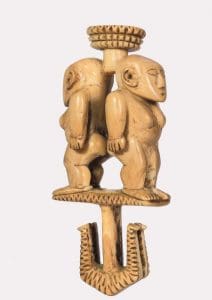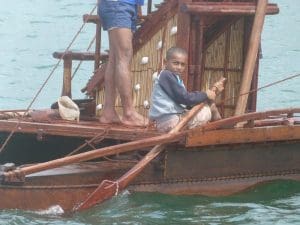
New Fijian double-hulled canoe being got ready to race. Photo courtesy Steven Hooper.
Fiji: Art and Life in the Pacific. Major 2016 exhibition at Norwich’s Sainsbury Centre will celebrate cultural highlights including superb canoe-building craftsmanship
By James Brewer
Art works, many of which have for years been ‘hidden’ in UK museum collections, will see the light of day when a substantial exhibition Fiji: Art and Life in the Pacific opens in October 2016 at the Sainsbury Centre for Visual Arts at the University of East Anglia, Norwich.
A centre-piece of what is said will be the largest and most comprehensive exhibition about Fiji ever assembled – running from October 15 2016 to February 12 2017 – will be a beautiful, newly commissioned, 8 m long double-hulled canoe that has been built in the South Pacific archipelago and shipped to Norwich for display, and not merely for display, but for sailing on the Norfolk Broads.

Setareki Domonisere, Fijian master canoe builder and sailor. Image courtesy Steven Hooper.
In addition to many stunning examples of sculptures, textiles, ceramics, and ivory and shell regalia – meant to be seen as artworks rather than artefacts – there will be much else of maritime interest, including splendid marine paintings of a century and a half ago.
The new canoe, commissioned by the Bundeskunsthalle in Bonn, Germany, and hand-built by craftsmen from the islands of Vulaga and Ogea in 2014-15 using traditional techniques and renewable resources, is of a type known as adrua.
This drua is a small version of the 30 m long vessels of the 19th century, the biggest canoes ever built. Product of a heritage project designed to foster canoe-building ability, it has a hull made entirely from wood and is sewn with coconut husk fibre cordage. It has a pandanus-leaf matting sail for display and a tarpaulin one for sailing.

Fijian War Canoe. Watercolour. By James Glen Wilson, 1856. Private Collection.
The builders, Setareki Domonisere (known as Domo) and his team, deployed their skills learned from building outrigger canoes, and studied the only remaining drua, a 100-year-old example 13 m long in the Fiji Museum. Such canoes were built up to 35 m in length in the 1840s and could transport 150 or more passengers and crew.
The new drua had its mettle tested when it sailed in the annual Hibiscus Festival canoe races in Suva harbour in August 2015 and is being shipped by container to the UK. It will take to the water in Norfolk in May 2016 as part of the exhibition outreach programme.

Feejeean & Tongese Canoes Getting Under Weigh at Levuka near HMSHerald. By James Glen Wilson, 1855. Private collection.
Voyaging canoes have carried people and goods around the region, including to Tonga, Samoa and other neighbouring islands, since 1, 000BC.
In all, more than 270 works of art, including European paintings and historic photographs, are being loaned by exhibition partner the Museum of Archaeology & Anthropology at Cambridge, and by the Fiji Museum, the British Museum, the Pitt Rivers Museum (Oxford) and museums in Aberdeen, Birmingham, Exeter, London, Maidstone, Dresden and Leipzig. The Sainsbury Centre, a leading public museum for the display of art of all nations, will devote its 900 sq m of galleries to the exhibition.

View of Tokou, Ovalau. Watercolour. By Constance Gordon Cumming. Courtesy Museum of Archaeology and Anthropology, Cambridge.
Contributing context will be artworks relating to Fiji including 1850s paintings by Irish artist James Glen Wilson, who was commissioned into the Royal Navy as an officer for the survey voyages of HMS Herald in the western Pacific. There will be 1870s watercolours by Constance Gordon Cumming, a globetrotter and prolific travel writer, who was taught by Sir Edwin Landseer and produced more than 1, 000 watercolours. Her best-known books were At Home in Fiji (1881) and A Lady’s Cruise on a French Man-of-War (1882, resulting from an invitation to join a French ship that called at Fiji).

Ratu Epenisa Seru Cakobau, paramount chief of Bau, c1873
The Norwich exhibition results from a three-year project funded by the Arts & Humanities Research Council which examined the considerable but little-known Fijian collections in the UK and overseas, and uncovered significant finds. Research project leader and exhibition curator Prof Steven Hooper said: “An important aspect of this exhibition is that the many examples of exceptional Fijian creativity on display are not presented as ‘ethnographic specimens’ or ‘illustrations’ of Fijian culture, but as works of art in their own right, as worthy of attention as any art tradition in the world, including Modernism. Remarkable creative imagination is applied to the making of ancestral god images, ritual dishes and regalia, and to the decoration of enormous bark-cloths.”
Woodcarvers and textile artists continue to produce sailing canoes, kava bowls (for the preparation of ritual drink) – and decorated bark-cloths, some over 60 m long, for weddings and mortuary ceremonies. In the current Pacific fashion scene designers are using bark-cloth and other local materials to make gowns and wedding dresses, showing their creations in overseas centres including London and Los Angeles.

Whale ivory double-figure hook. Courtesy King’s Museum, Aberdeen University.
Several bark-cloths from the 19th century with vibrant painted designs (one over 15m long) will be shown at the Sainsbury Centre, together with contemporary examples, including one 5 m by 2 m cloth with dramatic black and white lozenge designs “that would grace any European painting exhibition, ” say the curators.
The islands now called Fiji were first settled by voyagers from the west, probably from Vanuatu. During the next 3, 000 years further migrations expanded the population to over 120, 000 by the late 18th century, when Fiji was briefly visited by Captain Cook and Captain Bligh. After the mutiny on the Bounty in 1789, Bligh was chased by Fijian canoes and was fortunate to escape.
The 19th century saw the arrival of European traders, missionaries and planters, bringing metals and guns. After a first request from Fijian chiefs in 1859 to join the British Empire was rejected, Fiji eventually became a British colony in 1874, with Sir Arthur Gordon as first Governor. He and others based at Government House, including Baron Anatole von Hügel and the redoubtable Constance Gordon Cumming, were avid collectors of local objects and turned it into a kind of museum.
Much of this material was eventually sent back to Britain, hence the substantial collections at Cambridge, the British Museum and elsewhere. In Fiji Museum itself in the capital, Suva, there is a high quality collection. Although pre-Christian images, ritual objects and weapons ceased to be made after conversion to Christianity and the cessation of warfare during the 19th century, other traditions, such as canoe building and bark-cloth making, survived.

Tevita, Domo’s son, learning canoemanship. Image courtesy Steven Hooper.
Many objects were made to be transacted, which endowed them with commercial power. Fijian artworks include figure sculptures in wood and ivory, shell and ivory regalia and ornaments, many forms of bowl, elegant headrests, weapons (which can be strongly sculptural in form) and pottery.
Fiji, which consists of some 300 islands and 540 islets and has a population of less than 1m, gained independence in 1970.
Fiji: Art and Life in the Pacific will run from October 15 2016 – February 12 2017at the Sainsbury Centre, University of East Anglia, Norwich. www.scva.uea.ac.uk





